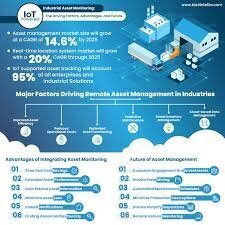IoT-Driven Asset Management
The integration of the Internet of Things (IoT) into asset management is transforming how organizations monitor and manage their financial and physical assets. By leveraging connected systems, businesses can achieve better oversight, enhance decision-making, and maximize asset utilization.
Role of IoT in Asset Management
IoT-driven asset management involves the use of connected devices, such as smart sensors and asset management platforms, to collect and analyze data in real-time. This technology enables organizations to track the condition, location, and performance of assets throughout their lifecycle, from acquisition to disposal. By implementing IoT solutions, businesses can reduce operational costs, improve productivity, and enhance asset longevity[1][2].
Benefits of AI and IoT Integration
Artificial Intelligence (AI) plays a crucial role in optimizing IoT-driven asset management. AI algorithms can analyze the vast amounts of data generated by IoT devices to provide actionable insights. For example, predictive maintenance can be implemented by analyzing patterns in asset performance data, allowing organizations to anticipate failures and schedule maintenance before issues arise. This proactive approach minimizes downtime and extends the useful life of assets[3][4].
Key Components of IoT-Driven Asset Management
-
Smart Sensors: These devices collect data on various parameters, such as temperature, humidity, and equipment performance. This information is transmitted to centralized platforms for analysis.
-
Asset Management Platforms: Cloud-based software solutions that aggregate data from multiple sources, providing a comprehensive view of asset performance and health.
-
Data Analytics: Advanced analytics tools process the data collected from IoT devices, enabling organizations to identify trends, optimize asset usage, and make informed decisions[2][5].
Applications Across Industries
IoT-driven asset management is applicable across various sectors, including:
-
Manufacturing: Real-time tracking of machinery and equipment helps optimize production processes and reduce waste.
-
Logistics: IoT solutions provide visibility into the condition and location of goods, ensuring timely deliveries and maintaining quality control.
-
Construction: Monitoring heavy equipment usage enhances security and reduces theft, while also improving operational efficiency.
-
Healthcare: Tracking medical equipment and supplies ensures availability and compliance with regulatory standards[1][4].
Conclusion
The adoption of IoT-driven asset management, enhanced by AI technologies, is revolutionizing how organizations manage their assets. By providing real-time insights and automating processes, businesses can achieve greater efficiency, reduce costs, and improve decision-making. As the market for IoT solutions continues to grow, the potential for more innovative applications in asset management will expand, driving further operational improvements across industries[3][5].
Further Reading
1. IoT in Asset Management — Why Is It Important? | Digi International
2. IoT in Asset Management and Monitoring | IoT-based Asset Management
3. IoT’s game-changing role in modern asset management | Smart Industry
4. IoT in Asset Management Solution: Trends, Benefits & Insights
5. Using IoT Asset Tracking for Asset Management | ServiceChannel


